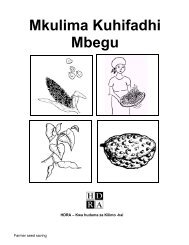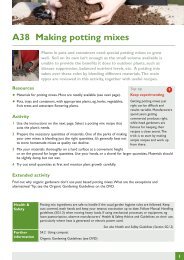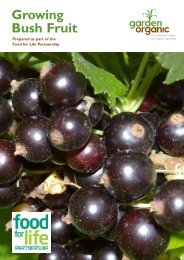Download PDF - Garden Organic
Download PDF - Garden Organic
Download PDF - Garden Organic
You also want an ePaper? Increase the reach of your titles
YUMPU automatically turns print PDFs into web optimized ePapers that Google loves.
http://www.gardenorganic.org.uk/organicweeds<br />
increase the reliability and efficacy of the stale seedbed method. The date and the<br />
prevailing conditions prior to and after soil cultivation have a strong effect on<br />
seedling numbers and timing of emergence. For example, in spring the mean seedbed<br />
temperature in the week after cultivation and the number of seedlings in the flush of<br />
emergence are highly correlated (Vleeshouwers, 1997).<br />
Cultivation in darkness<br />
It is known that light can break weed seed dormancy and stimulate germination.<br />
Although it was known in the past that a brief exposure to light of weed seeds buried<br />
in soil promoted a flush of seedling emergence, it was considered only recently to be<br />
of practical importance (Hartmann & Nezadal, 1990). Cultivation in the dark has<br />
been shown to reduce weed emergence by up to 70% but it is often much less<br />
effective (Ascard, 1994; Börjesdotter, 1994; Scopel et al., 1994), and it still leaves<br />
enough weeds to reduce crop yield. Fogelberg (1996) found that night time<br />
cultivation could reduce weed numbers by 25% compared with daytime cultivation.<br />
However, no difference was found between one-time harrowed plots and twiceharrowed<br />
plots. Fogelberg (1999) found only a small, and not always significant,<br />
reduction in weed numbers following seedbed preparation and carrot drilling in<br />
darkness. After intra-row brushweeding, there was little difference between carrot<br />
crops drilled in the dark and others drilled in the light. Daytime cultivation with a<br />
moldboard plough stimulated weed seedling emergence 200% greater than night-time<br />
ploughing (Botto et al., 1998). However, when a chisel plough was used weed<br />
emergence was much greater overall and there was no difference between night and<br />
daytime cultivations. Covering soil with opaque material immediately after<br />
cultivation or leaving it exposed to light made no difference to weed emergence<br />
suggesting that it is the exposure to light during cultivation that is important.<br />
There are several reasons why cultivation in the dark does not give consistent results.<br />
There is some evidence that exposure of imbibed seeds to periods of chilling and<br />
warming can affect their light sensitivity (Hartmann & Mollwo, 2000). Not all weed<br />
species have light sensitive seeds (Leake, 1999). whilst the seed of others can lose<br />
their light requirement with age. Welsh et al., (1999) found that the emergence of<br />
common chickweed (Stellaria media) and fat-hen (Chenopodium album) was reduced<br />
by cultivating in darkness but that of blackgrass (A. myosuroides) was unaffected. In<br />
addition, some light sensitive species like the mayweeds (Matricaria spp.) are smallseeded<br />
and will only emerge from shallow layers of soil. Therefore, seeds left near<br />
the soil surface following dark cultivation may still receive sufficient light in order to<br />
germinate.<br />
Light penetration into the soil surface depends on soil density, particle size and<br />
moisture content (Baumgartner, 1953). Reflection depends on the darkness of the soil<br />
and this is influenced by moisture. The soil may filter the light and alter the spectrum.<br />
Generally light does not penetrate through soil particles only through the pores by<br />
reflection off the particles. The bigger the particles, the bigger the pores and the<br />
deeper the light will penetrate. Only about 1% of light penetrates up to 6-8 times the<br />
particle diameter. The least light penetration is in clay soil. The results of<br />
experiments comparing the effect of cultivation in the light and in the dark on<br />
seedling emergence are dependent on cultivation intensity and the choice of<br />
implement (Jensen, 1995). Prolonged exposure to moonlight or even starlight may be<br />
October 2007 6








